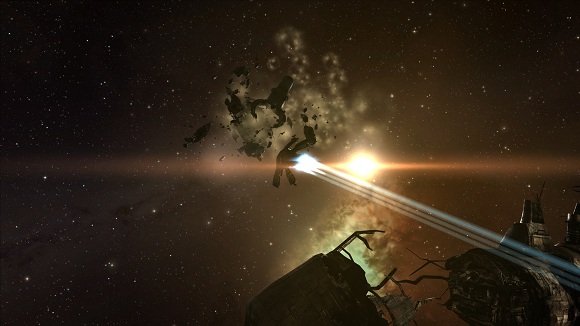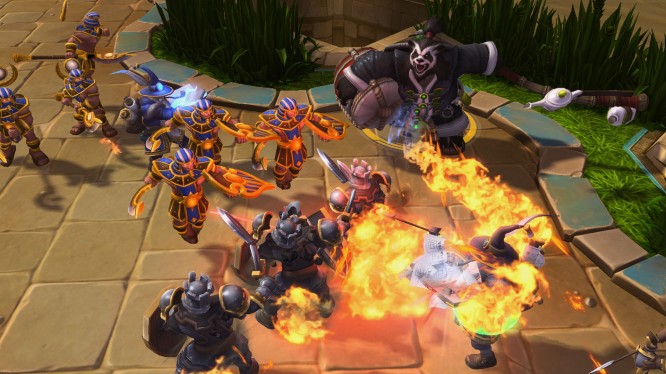In Episode One of the Eve Online Beginner Guide, we spent some time covering the initial player experience, which ranged from creating a character to completing the tutorial, and everything in between. We left off where the tutorial ends and the training begins; when you are sent forth from the comfortable confines of your home system to meet 5 career agents that will give you the chance to experiment with the 4 core elements in Eve Online: Industry, Exploration, Military and Business.
Having arrived now at your new home and completed the final mission from Aura, you’ll be introduced to five agents, whose missions can be accepted and completed in exactly the same way as those given to you in the tutorial. Below, we’ll cover each of these agents in detail, and discuss in more depth how they correspond to the different career paths on offer in Eve Online.
As each of these agents are unique to your starting area, most players will find that the agents offering these missions vary depending on their choices made during character creation. That said, the individual missions will remain much the same.
 Choices. So many choices. This is where it all begins.
Industry Agent
Choices. So many choices. This is where it all begins.
Industry Agent
The Industry Agent will offer you a wide variety of mission types, beginning with mining and manufacturing and wrapping up with trade, and will introduce you to the one of the 3 core elements of Eve Online: Craft.
In order for a ship to be destroyed in a glorious fleet battle, it must first be manufactured, as must the various weapons and modules that are fitted to it. Manufacturing is a complex, time-consuming process that can take a player several years to fully grasp, and we’ll have a specific guide to manufacturing ready sometime this century. For now, you’ll only need the basics, and this tutorial agent will help you learn them all.
First, you’ll need minerals, such as Titanium and Isogen, to begin your manufacturing process, and the most common way to acquire them is to extract them from ore. Ore is found in asteroids scattered across the galaxy, and thus begins the first element of manufacturing: Mining.
 I snapped this shot on my first mining run. I liked mining back then.
I snapped this shot on my first mining run. I liked mining back then.
During this mission chain you’ll be given a small Frigate with a bonus to mining, and Mining Laser, the two fundamental elements of mining and asteroid belt. You’ll also be directed to your first asteroid belt, and upon arriving, be shown how to target an asteroid and extract the ore inside.
Like everything in EVE, this is only the most basic form on mining, and over the coming months, those of you with a sound interest in sucking ore from asteroids will expand further with the inclusion of Mining Barges, Asteroid Scanners and Industrial Barges, which will increase your ore yield exponentially.
With your ore secured, the next step is to Reprocess it into the minerals you’ll use for manufacturing. Again, the missions in this chain will explain everything you need to know in order to achieve this, but it can be a lot to digest; in reality, it a simple matter of [Right-Clicking] the ore in your Items Hanger (not your ship cargo hold – be sure to move it over) and selecting reprocess from the menu. How much of what minerals you’ll receive is determined by the type of ore, and your skill level in Refining.
 This overly-complicated-mess-of-a-screen is what manufacturing (crafting) looks like in EVE. Don’t worry, it makes perfect sense after the first 200 hours.
This overly-complicated-mess-of-a-screen is what manufacturing (crafting) looks like in EVE. Don’t worry, it makes perfect sense after the first 200 hours.
Now you should have your minerals (in this case, Tritanium) and a new mission designed to introduce you to manufacturing. For this, you’ll need a blueprint of the item you want to make (also provided in the mission), a ‘slot’ in a space station with manufacturing functionality, and a small stipend of cash for every hour that you’ll need to use it. There are usually enough slots in most of the starting areas to allow you to complete this mission; however, if you find that they’ve all be taken, you can head out to a new station, or queue up your job to begin as soon as a free slot emerges.
Now, simply [Right-Click] the blueprint and select manufacturing, which will give you a few options before giving you a quote on the material cost of production. From there, it a waiting game, and the end of our tutorial on Industry. There another core element, Trade, that we haven’t discussed, but as managing the market is a game on it own, we’ll save that for another guide.
Exploration Agent
Exploration in Eve Online is a genuinely unique experience, and as such, is considerably more complicated than it sounds. That said, the basic idea is quite simple; you send probes out into space that scan down hidden objects and locations. In doing so, you open yourself up to discovering a wide variety of awesome lootz, such as rare blueprints, asteroid belts and enemy outposts.
 There’s something magical about your first find. Breathe it in. Enjoy it. You’re probably not going to find another one until next week.
There’s something magical about your first find. Breathe it in. Enjoy it. You’re probably not going to find another one until next week.
The Exploration Tutorial Agent will, as all others, give you a basic outline and understanding of this process, and too, offer you the chance to hunt down the 5 different types of signals your scanning probes can track: Radar, Ladar, Magnetometric, Gravimetric and Unknown.
However, before you’re able to begin this process, you must first complete a mission designed to introduce you to an entirely different method of scanning, that uses your ships’ on-board scanner in lieu of scanning probes. On the plus side, this process is infinitely less complicated than the latter; however, the rewards are considerably less fruitful, as the only type of signature you’ll be able to track is a Cosmic Analogy, which only offer small combat scenarios with limited rewards. This process is so simple that I’m actually not going to mention it here; if you have difficulty with it, forget exploration forever. This rabbit hole is a deep one, and should only be attempted by those with a suitable level of discipline and patience.
Now, back to the hard stuff: before embarking on your first ‘real’ scanning mission, I recommend that you find yourself a frigate with a bonus to exploration. The tutorial will not provide you with a frigate, but will provide you with a Core Scanner Probe and Probe Launcher, which you’ll need in order to release probes and begin exploring space.
 I feel this screen clearly explains itself.
I feel this screen clearly explains itself.
You’ll also be provided with a number of Civilian Modules, such as the Codebreaker, Analyzer and Salvager. These modules normally require training to be used, but as they are civilian grade, can be used (with obvious limitations) for the purposes of the tutorial without training.
And now, the tricky stuff. I’ll say it right now to avoid any confusion: we can’t teach you exploration in this guide. We’ll write another one soon that will try to make the process easier, but in the end, this is a matter of patience, discipline and time. CCP have released an awesome video tutorial that can help you here, and this link should give you a much better understanding of what you can expect to find in each of the sites.
Back to the tutorial, you’ll be asked to scan down each of the sites mentioned above in order, and upon doing so, use the correlating module to access to the loot where applicable. Begin by fitting your ship with the required modules, and undocking from station. From there, active your probe launcher to release a probe, open up your Starmap [Crtl-M], and switch to Solar System view.
You should be able to see your probe now, indicated by a white cube with arrows protruding from each side, and a large bubble in the surrounding area. This indicates your probes position in space, and the bubble, its search radius. Open your scanner [Ctrl-D], click scan, watch the pretty circles, and after a moment, your signal will appear in the scanner window.
 Directional Scanner Instructions for Use: Step 1 – Click Scan.
Directional Scanner Instructions for Use: Step 1 – Click Scan.
Then rinse and repeat, slowly narrowing your search each time, until you have a 100% lock, and warp to the location. It a lot harder than it sounds, and that why we’d prefer to cover it in a tutorial on it own (including the use of multiple probes, shortcut keys to make the process easier, etc), but this should be enough to get you through the tutorial, and let you decide whether or not exploration is the path for you.
Military and Advanced Military Agents
The Military and Advanced Military Agents in EVE make up the bulk of the tutorial process. They’ll cover everything from fitting your ship with a variety of different modules specialsed for a variety of difference combat scenarios, to insuring your ship, getting yourself killed and recovering from your loss.
Fortunately, these missions (unlike many from the distribution, industry and exploration agents) are almost exclusively simple in design; for the most part, your mission will consist of heading out to an area in space and annihilating your opponents, with few exclusions.
 Mining is serious business. It’s also dangerous business. Bring friends.
Mining is serious business. It’s also dangerous business. Bring friends.
You’ll learn how to equip modules like the Afterburner I, which provides a speed boost to your ship, Statis Webifier I, which slows down an enemy ship, preventing them from escaping and also increasing your ability to target them, and the Warp Disruptor I, which prevents an enemy ship from activating their warp drive and escaping a battle.
All of these, and plenty more, are fundamental elements to military combat in EVE, both in PvP and PvE scenarios, and should be experienced by all players. Moreover, you’ll get plenty of skill books and modules that will greatly increase your combat effectiveness, not to mention some very nice ships, including a Destroyer.
As for the missions themselves, there isn’t a lot we can say to help you through them, as they’re very similar to the standard missions in the initial tutorial and shouldn’t cause you any trouble. Just be warned; read the mission text. During one mission, you’ll be asked to change to a new ship, fly out to a station and kamikaze into it. If you forget to switch ship and insure, you could be in for some painful loss.
 BOOOOOOO
BOOOOOOO
OOOM!
Business Agent
The Business agent focuses on common business practices and scenarios you’re likely to encounter early in the game. I’d recommend completing this agent after exploration, military and industry as the missions combine factors from all three. Ranging from simple jobs like acquiring and delivering an item, to lengthy manufacturing contracts, these missions will help you get the hang of more common elements like the market.
The Business agent is unique in that they don’t care how you obtain what they require, only that you get the job done. For example, one mission requires you to deliver a number of manufactured units to your agent. While it is suggested that you should create these yourself using mining and manufacturing skills, the process will take several hours. On the other hand, the shrewd businessman can check the market for the items they need and, if the price is right, simply buy the items to complete the mission and still turn an instant profit.
 Take a good look. Should you choose a career in business, this is where you’ll be playing EVE.
Take a good look. Should you choose a career in business, this is where you’ll be playing EVE.
Business and distribution may not sound like the most appealing career path in New Eden, and that because it isn’t. It a long, slow job, and as such, it one in high demand. There a lot of money to be made in EVE by doing the dirty jobs, and distribution is right at the top of that list. Common examples of this range from buying items on the market at low prices, and transporting them to systems where they fetch a much higher price, to organising contracts with other players and corporations to do their heavy lifting for them.
Those of you considering distribution as a career path should begin training in the use of Industrial Ships, as they have significantly larger amounts of cargo space than most other ship types, allowing you to transport more goods in less time.
As for the agent missions, it a good idea to complete these anyway, even if business doesn’t sound like your cup of tea. Not only are they simple, they offer some pretty nice rewards, including skill books, fittings, ships and a nice stipend of ISK.
 If you’re good in business, you might get to fly this.
Moving Forward
If you’re good in business, you might get to fly this.
Moving Forward
Having completed some (hopefully, all) of the agent training missions outlined above, you’ll be ready for your first real challenge in EVE: the cliff. Aptly named, ‘the cliff’ refers to the moment in EVE where the hand-holding ends, and the sandbox begins.
You’ll need to begin choosing your focus, and as you’ll hopefully now understand, there are many from which to choose. Our next installment in this series, Episode 3: Choosing a Focus, will introduce you to each of the 12 core career focus paths in EVE.
Visit the EVE Online game page to find out more!
Click here to read part 2 – Career Agents
Click here to read part 3 – Choosing a Focus


 THE PANTS MAN COMETH!
THE PANTS MAN COMETH!



















 MOBA Monday: 5 tips for Supports in League of Legends
MOBA Monday: 5 tips for Supports in League of Legends WoW Wednesday: Starting Over Again in World of Warcraft .
WoW Wednesday: Starting Over Again in World of Warcraft . Star Stable: Top 5 Tips for Racing
Star Stable: Top 5 Tips for Racing 5 Ways to Up Your Game in Heroes of the Storm .
5 Ways to Up Your Game in Heroes of the Storm . Tribal Wars 2 Interview: Nino Protic, Senior Product Manager .
Tribal Wars 2 Interview: Nino Protic, Senior Product Manager .